
23 minute read
INTERVIEWING
General Loss Interviewing: Part One
“All my life’s a circle; Sunrise and sundown,” sang Harry Chapin. It may be just a natural part of life, but it seems like what was comes around again. Wide and narrow lapels and ties, pedal pushers now capris, bell-bottom pants, chukka boots, Nehru jackets, but, thankfully, leisure suits have not seen fit to return in force yet.
It seems, though, general loss interviewing has returned as an investigative tool once again. Over the last year we have had a number of organizations request information and training about how best to conduct general loss investigations.
History of General Loss Interviewing
For those who may not be familiar with general loss interviewing, it was a common practice, maybe thirty years ago, to walk into a high-shrinkage store or department and interview all the associates in an attempt to determine the cause of shrinkage in the location. Remember, this was an age where inventories and store controls were in their infancy. The store had a 5 percent shrink and investigators were not sure if it was the result of paperwork, or internal or external dishonesty. The idea that one could know the store was actually missing two sweaters, their style, and colors, was unthinkable back then. Was it a problem with refunds, which falsely appeared to be a merchandise problem, or was it a serious shoplifting problem contributing to the losses? Investigators entering the store rarely had any information to help them resolve the shrinkage other than to talk with each associate to find out what they knew.
Today organizations are blessed with the ability to closely establish a store’s inventory and product selection, plus companies have exception-reporting systems to target poorly trained or dishonest store associates. The exception-reporting programs allow loss prevention to mine the extensive store data and identify potential dishonest employees at the location. Many companies today prefer to limit employee interviews to those they have clearly established are stealing from the location. Using an exception-reporting system, organizations can now focus their investigative resources on the individuals most likely to be involved in theft and then clearly prove that. However, there will be certain cases where shrinkage may not be attributable to a particular associate or operational inefficiency making general loss interviews a technique of choice.
by David E. Zulawski, CFI, CFE and Shane G. Sturman, CFI, CPP
Zulawski and Sturman are executives in the investigative and training firm of Wicklander-Zulawski & Associates (www.w-z.com). Zulawski is a senior partner and Sturman is president. Sturman is also a member of ASIS International’s Retail Loss Prevention Council. They can be reached at 800-222-7789 or via email at dzulawski@w-z.com and ssturman@w-z.com.
Internal Resistance
Once loss prevention has made the decision that general loss interviewing may be an effective way to reconcile shrinkage in a high-loss location, the next priority is selling the decision to human resources, legal, and operations. Many times the decision to do general loss interviewing will face resistance because of perceived difficulties and operational problems caused by the investigators in the store.
In addition, there may be additional problems in the wake of a general loss investigation. For example, in one high-shrink location on the East Coast, we obtained theft admissions from the entire management team and staff at the location. This resulted in the termination of everyone at the store by the end of the day, which left the district manager with no one to operate the location. In most instances it is difficult to know the extent of the problem until the interviews have concluded.
Another potential problem is the perception of how the interviews will be conducted in the store. Many members of human resources, legal, and operations have the perception that each of the employees will be accused and “interrogated.” Wisely, they are reluctant to put their people through that situation without evidence of wrongdoing.
The general loss interviews have the potential to cause personnel and legal problems if they are not handled correctly. The selection of the interviewers should be carefully done with an eye toward their skills and evenhanded personalities. Generally, the organization’s best and most experienced interviewers should be used for general loss investigations. In addition, the location
selected for general loss interviews should be investigated using traditional means in an attempt to identify the reasons for the shortage first.
Selling to Management
When selling the general loss interviews to the other management teams, it is often beneficial to walk them through a non-confrontational approach to the interview. It is often helpful to simply ask a series of questions and let them respond. ■ Is it permissible to have a voluntary conversation with an employee about business practices at the store? ■ Is it permissible to ask an employee about his position and job responsibility at the store? ■ Is it permissible to tell an employee about what loss prevention does and its scope of responsibility? ■ Is it permissible to tell an employee about how losses occur and the types of document manipulations that may contribute to losses in the store? ■ Is it permissible to tell an employee about the investigative methods loss prevention uses to identify people responsible for losses in the store? ■ Is it permissible to tell an employee about some of the reasons people make errors in judgment and take things from the company? ■ Is it permissible to ask an employee if they have taken money or merchandise from the store?
In most cases the management teams will acknowledge that in each and every one of the above questions, an employee may be told or asked about the topics. They have in effect agreed that the use of an introductory statement is an appropriate pathway to conduct an employee interview in a high-shrink store. This conversational non-confrontational approach allows an investigator to have a conversation with the associate and make a determination whether to proceed with the inquiry or look for other operational or external problems at the location without creating morale issues.
Potential Outcomes
Part of the discussion with the management team should revolve around the potential outcomes following general loss interviewing. One disconcerting result of general loss interviewing is discovering that the store is operating significantly differently than the organization’s strategic plan. In essence, there is a big difference between what we think is happening and what is really happening at the store level.
As part of the team approach, consideration should be given to staffing levels during the interviews, plans for hiring replacement workers should individuals be terminated for theft or policy violations, and the level of confidence in existing management at the store. In a large number of the general loss investigations that we have been involved in, it was a management problem that allowed the losses to accumulate. Most investigators who have entered a store and found the location dirty and disorganized have come to find that this is a breeding ground for theft and shrinkage. In addition, employees who are not attentive to customers and operational policies are generally allowed to exist because of poor supervision and management at the location.
The other management teams should also expect secondary information to arise during the interviews related to sexual-harassment, hostile workplace issues, poor management practices, and violation of policies and procedures, which contribute to the overall health of the store. An important part of the general loss interviewing is partnering with the other management teams to successfully resolve the issues uncovered. The general loss interviewing will create additional work for a variety of people to deal with, and they should know in advance the potential outcomes from the investigation.
Besides resolving the shrinkage problem, another positive aspect of the general loss interview is the opportunity to do loss prevention awareness training with each associate on a personal level. These interviews can also be used to reinforce policy and procedure, shoplifting awareness, and make the associate feel an important part of the company’s operation.
Upcoming Columns
In the next several columns we will deal with the initial organization of the investigation in a high-shrink location. There are a number of options investigators have to plan and execute their investigations. Some of the options can streamline the process, generating significant information prior to the arrival of investigators at the store, while others offer little or no help. We will focus on those strategies that we have found most beneficial in concluding a successful investigation. However, because many organizations have different resources, financial constraints, and personnel policies, we will also include those approaches that are more difficult to use.
W-Z Tip of the Week
Visit the EyeOnLP.com page for weekly advice and suggestions on all things interviewing from Michael Reddington, CFI.
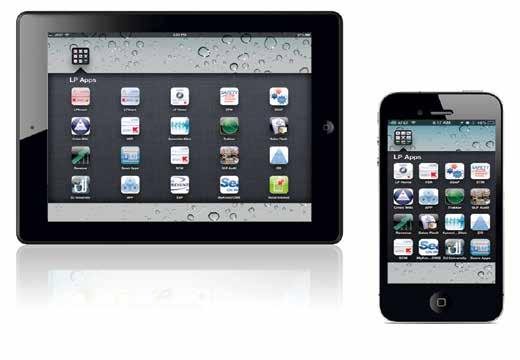
Imagine walking into a location for a visit. As you sip your morning coffee, you pull up the store’s current performance from your iPad or tablet PC. At a glance you have all the vital statistics and performance trending information you need.
As you enter the store, the tablet’s GPS identifies your location and sends you three alerts that require your immediate attention. During your visit you identify possible signs of theft, so you pull the IP-video CCTV feeds from your tablet and review the footage.
A week later you complete a follow up visit from two states away via video-chat from your tablet.
Do these ideas sound like some far-fetched dream of a future loss prevention organization? They are not. This is the present at Sears Holdings.
While our customers are accessing Shop Your WaySM special member offers from their mobile devices, our Sears and Kmart loss prevention teams are using similar devices to dynamically access performance rankings, theft statistics,
outlier reports, and a vast array of other data, reports, and charts that visually demonstrate the risks and relative “health” of a given store location, district, or region.
As our economic and technological landscapes have changed, so has the loss prevention industry. More often, loss prevention and retail in general are being challenged to do more with less. How can we drive profit while mitigating risk and improving performance? Our strategy at Sears Holdings has always been to empower our teams with technology that helps them increase efficiency and make informed decisions.
Technology Is a Journey
We started on what we call our “digital journey” over five years ago with a series of incremental steps aimed at leveraging the emerging technology landscape. At the time we had no idea smart devices were the end game, but we knew that to stay competitive, we needed to be prepared for the future.
Every time we’ve considered implementing new technology, our first step has always been to review our current processes and ask ourselves three questions: █ Can we eliminate this process or task? █ Can we centralize this? █ Can we automate it?
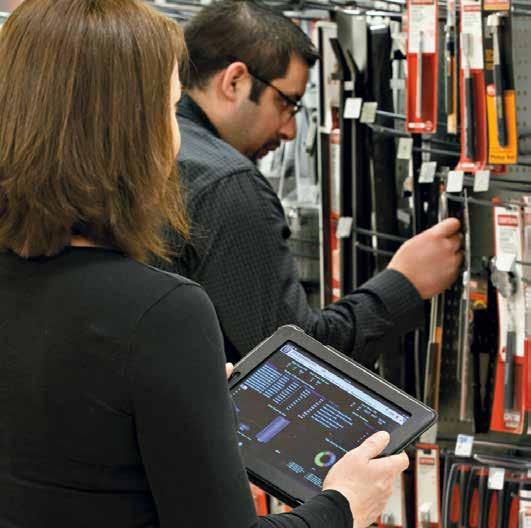
Loss prevention team members using the mobile applications during a store inspection.
The external dashboard allows the user easy access to review not only external-theft performance, but it also provides quick access to narratives and exceptions. The field teams can now quickly validate case procedures and ensure each report is written correctly.
Each iPad is managed via “Over the Air” (OTA) programming. Every team member’s iPad is automatically configured with the apps, email, and VPn to ensure a simple initial setup.
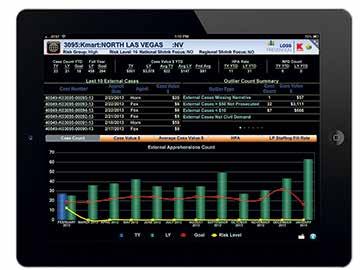
We call this process “task modernization.” From our first web-based applications to our current mobile solutions, our vision has always been to leverage systemic and technological advances that deliver the highest value to the enterprise. This digital journey is not about technology for technology’s sake; it’s about giving our professionals a competitive advantage in understanding their business and making informed decisions.
Investing Strategically
The demands of end users have continually exceeded network infrastructures, but as quickly as network providers can meet demands, consumers and developers create new ones. This cycle of evolution continues throughout the landscape—IP phones have replaced traditional landlines, smartphones have replaced cell phones, online video has replaced video rental stores, e-books have replaced book stores, and we all know what happened to the music industry. Consumers have even connected their homes to control everything from their alarms to their thermostats via smartphone. With so much change in technology, how can the loss prevention industry keep up?
Our first priority has been to invest in data. From collecting data about theft to census data to enhance environmental risk models, our ability to make actionable decisions based on business results, trends and outlier activities consistently results in the greatest payback. Similarly, we constantly challenge ourselves to better manage our data and improve the delivery method to end users. The focus is to make our teams more agile and prepared with actionable information. We’ve always believed that knowledge is power, and our technological investment decisions reflect that philosophy.
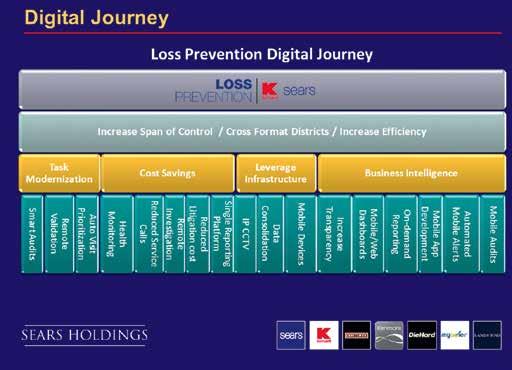
An early version of Sears Holdings loss prevention digital roadmap depicts how leveraging technology can increase overall efficiency and reduce cost.
continued on page 18
Your Secret is Out.
With ShelfNet, it Won’t Be.


TM
The Right Products in the Right Place at the Right Time.
It’s no secret that on-shelf availability is critical to retailers. By reducing out-of-stocks by just 2%, you can see at least a 1% increase in sales, not to mention improved customer loyalty. ShelfNet wirelessly uses your current pusher system to deliver information to you 24/7 – critical data that can revolutionize your current inventory system and bring you an immediate ROI.
To improve your OSA, contact: Debra Skolnicki, Key Account Director 440-984-8660 DebraSkolnicki@alphaworld.com
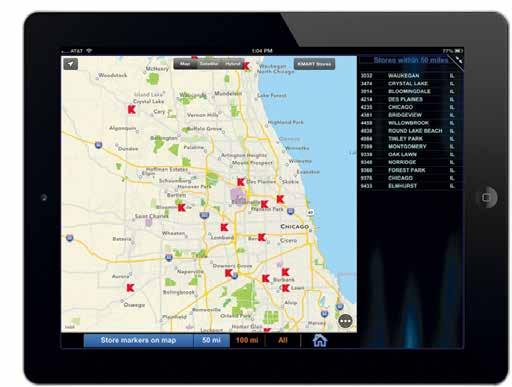
By integrating our app to take advantage of the iPad’s built-in gPS, users can quickly see stores nearby. By tapping on any store on the map, the user can pull up vital statistics for each store, including shrink and other key metrics.
users can view live video and control each PTZ directly from their iPad or iPhone. users can also access pre-recorded video on the device to aid with an investigation. continued from page 17

We began our journey years ago by transferring our data from a myriad of spreadsheets and disparate sources to a uniform data storage platform. This paved the way for the establishment of key metrics on our business and a means for developing goals and rating mechanisms for our locations.
Our latest investment in a business intelligence platform has allowed us to standardize and optimize reporting on key areas of loss prevention, such as theft, shrink, labor utilization, and investigations, as well as non-LP-related areas, such as sales, financial, and pricing.
We’ve taken advantage of the explosive growth in mobile computing by equipping our field personnel with iPads, giving them access to data via a quick swipe of a finger that might have required hours to compile in the past.
We invested the better part of a year preparing our infrastructure for the new devices: █ We updated our existing web applications to properly render on the new screens. █ We built iOS applications to truly take advantage of all the capabilities of these devices, such as the accelerometer, GPS, and touch navigation. █ We built mobile device management (MDM) profiles specific to our team’s needs to manage application deployment. █ We invested in a team of professionals who created visually insightful charts and reports that allow field personnel to instantly view trends over time, performance to goal, and performance relative to peers.
Our Journey Continues
We are busy developing models to help us explain the past and predict the future. We’re able to implement those models through our business intelligence platform to create scoring algorithms, cluster algorithms, and regression-based metrics.
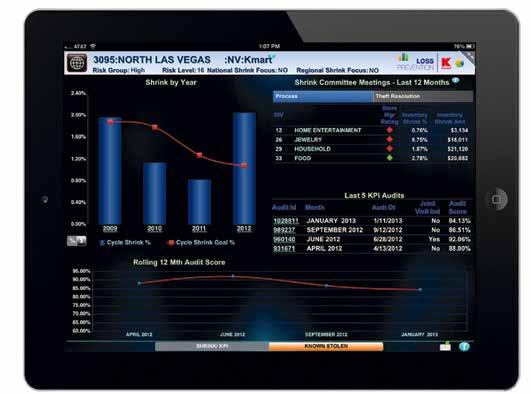
The shortage control dashboard provides the user a one-stop page to review shrink performance, meeting participation, and audit results. Every panel is interactive, allowing the user to drill down and access outliers with a tap or swipe of the finger.
We are busy developing models to help us explain the past and predict the future. We’re able to implement those models through our business intelligence platform to create scoring algorithms, cluster algorithms, and regression-based metrics. This sets the stage for even greater peer-topeer benchmarking, outlier analysis, and forecasting methodologies.
This sets the stage for even greater peer-to-peer benchmarking, outlier analysis, and forecasting methodologies.
Giving our field teams the ability to “analyze on the fly” has provided a real return on investment for our LP enterprise since deployment five months ago. Some key advantages we are realizing here at Sears Holdings include the following: █ Store visits that used to take a full day are now completed in a few hours, often allowing managers to visit multiple stores in a day. █ Everyone in the company has access to the same information, allowing for true transparency in reporting and alignment of goals. █ Managers can consistently drive key behaviors by ensuring the most important aspects of performance, such as compliance, meeting notes, and case performance, are covered during every visit. █ Access to store outliers and the ability to dive deeper into results allows our team to work almost exclusively from the iPads. █ Access to our IP-video CCTV allow our teams to easily review video from their mobile devices without having to be in store.
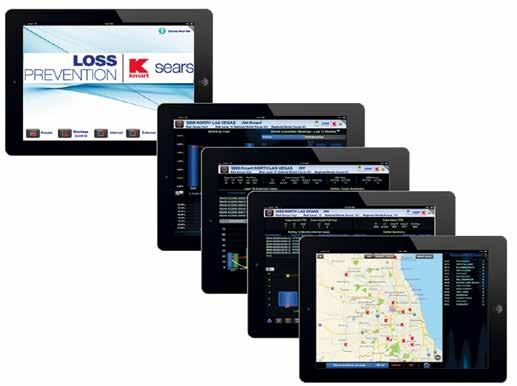
Redefining Talent
To improve the science of data, we have added statisticians to our team. To enable agility and speed in our product creation, we now have dedicated developers inside our LP organization. To manage our infrastructure and integrate with IT, we have team members with backgrounds in data architecture, project management, and systems. To combat the modern day thief who wields a computer instead of a lined bag, we have an experienced online fraud team. Our investigators are skilled in SQL and other query tools.
The traditional loss prevention roles within the corporation have changed. Making streamline simplified technology available to our field teams involves a complex
The LP mobile homepage serves as the launching pad for each of the loss prevention iPad applications. This integration allows the user to jump between applications without having to exit the app itself.
It’s a Cinch.
The Mini Spider fits your need to protect smaller, high-theft boxed goods.
Our 2 Alarm Mini Spider Wrap® is the perfect solution for protecting smaller packaged merchandise. Its strong clutch mechanism provides tightly cinched security for boxes too small for larger wraps. Maximize your display opportunities with confidence and see how easy it is to experience our proven ROI.
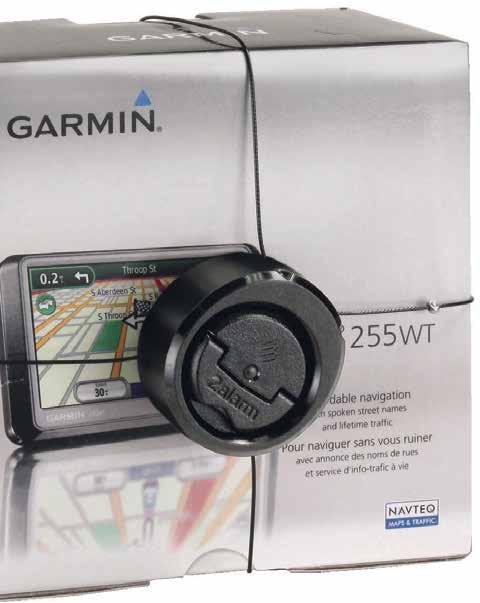
For more information, contact your Alpha sales representative or call 888-257-4272.
team of players who spend their day analyzing consumer and criminal behaviors, both in-store and online. At the corporate level we’ve created new teams, such as: █ LP Systems and Technology works as our liaison between
LP and IT to ensure we are involved in system changes, infrastructure upgrade, and have a voice on new company initiatives, including mobile checkout, loyalty promotions, and so forth. █ LP Business Intelligence works to design and develop new mobile and web applications and reports for our field and corporate users. █ LP Analytics works on researching and developing new performance metrics and predictive models to gain insights from our data and performance.
From our web applications to our mobile solutions, we have always held the belief that when the content experts—in our case, loss prevention—are responsible for application design, the end user always wins. We currently design and develop our own mobile apps, which have allowed us to reduce the time to deployment considerably.
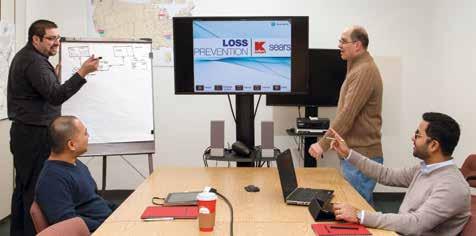
The Sears Holdings’ development team discuss mobile application workflow and design. Left to right is (standing) Carlos Bacelis, senior director of LP operations and analytics; Emil Santos, lead developer; Don Burkett, divisional vice president of systems/technology; and (seated) Ram Kandukuri, director of LP business intelligence.
█ e-Commerce/Payment Systems teams are an integral part of investigations, scouring millions of online transactions annually.
The same kinds of transformations are also true for our field teams. Traditional security roles are still vital, but we’ve also adjusted our core competencies to include a Digital Innovator section. This new section helps us identify competencies, such as forward thinking, early adopters, computer literacy, and systems knowledge.
From our web applications to our mobile solutions, we have always held the belief that when the content
continued on page 22
Milestone XProtect® is the world’s leading IP video surveillance management software and is reliable, future proof and easy to use. It supports the widest choice in cameras and seamlessly integrates with business and security solutions such as video analytics. Which means your possibilities are unlimited and you can keep your security options open. Milestone also offers the choice of three flexible ways to view your surveillance system: XProtect Smart Client, XProtect Mobile and the new XProtect Web Client. Designed by Milestone, XProtect clients work with all XProtect video management software. With the ability to access video from various locations as well as computers and mobile devices, there is an XProtect client to suit all your needs. Discover more with Milestone and try our software for free at: www.milestonesys.com
XProtect® Smart Client
XProtect® Web Client
XProtect® Mobile
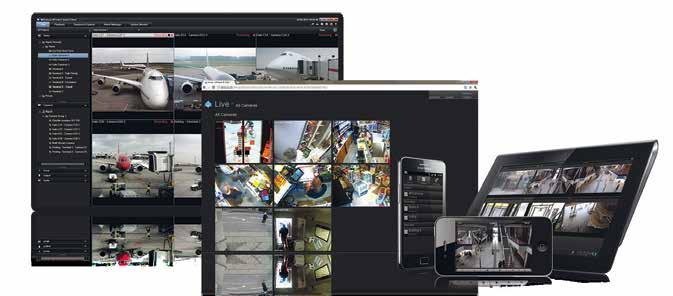
Milestone Systems U.S. Tel: 503 350 1100

continued from page 20 experts—in our case, loss prevention—are responsible for application design, the end user always wins. We currently design and develop our own mobile apps, which have allowed us to reduce the time to deployment considerably. Additionally, having teams who work with loss prevention and safety data daily allows them to build up expertise and anticipate the needs of the end user.
The Future
What we have developed thus far should only be considered our beta version. We are continually reiterating and refining our existing dashboards and audits to be smarter. At this point we have provided our store teams with faster customized access to information.
Our next challenge is to build enhanced automation, alerts, and scheduling into our various systems. Building on the concept of intelligent reporting, we will develop a calendar app to help our teams schedule the most important tasks and improve time management. We are building “smart audits” to manage which questions are asked in each store, based on each store’s specific opportunities. More importantly, we are integrating our various systems into a single core application to drive greater efficiency. Whether you’re accessing POS exceptions, financial reports, CCTV, or training programs, everything our teams do will be seamless and integrated.
Whether the next device innovation takes the form of a wrist watch or some type of virtual heads-up display, it is certain technology will continue to evolve. Be prepared to say goodbye to your PC and your laptop. Eventually, tablets will go the way of the VCR, but you can be sure whatever replaces it will be connected and mobile.
After all, it’s a journey, not a destination.
WILLIAM M. TITUS is vice president of loss prevention for Sears Holdings Corporation. Prior to his appointment to VP of LP at Sears, Roebuck and Co. in April 2003, Titus was senior VP of LP and risk management at OfficeMax. He also held LP and operations management positions with T.J. Maxx and Montgomery Ward. Titus is chair of the Loss Prevention Research Council and past chairman of the National Retail Federation loss prevention advisory committee. He holds a management and accounting degree from the University of Southern California. Titus can be reached at 847-286-1945 or william.titus@searshc.com.
MERCHANDISING SYSTEM
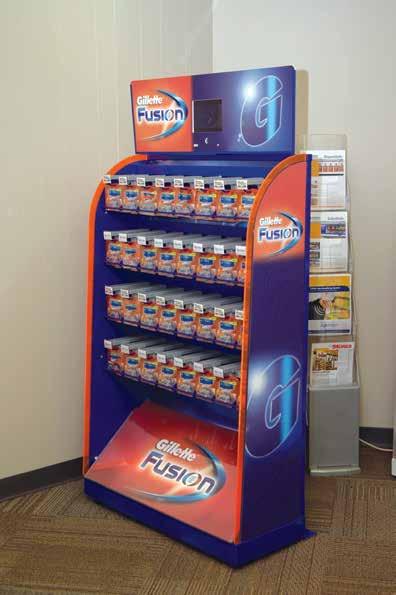

OPEN combines security with open merchandising.
Locked up items discourage shoppers.
Unlock your merchandise!
OPEN Merchandising System is a shopper-friendly product security solution that is tough on shrink. OPEN detects product removal and sends alerts in the event of sweep via alarm, pager or intercom system.
88 Shrink Reduction88 Shrink Reduction 1414 Sales Increase Sales Increase < <8 mo

Sandy Chandler, LPC, CPP
Regional Director, Loss Prevention Rite Aid Corporation
With the evolution of our profession, it is imperative that retail LP professionals become true business partners. Whether you are a seasoned LP professional or just starting out, the Foundation certification courses have valuable content to meet that goal.
These courses contain a wide range of subject matter that validates our ever-changing roles, showing how valuable our position is to our retail organizations. The LPC allowed me to become more proficient on some subjects not previously utilized. For example,
“I have a job. Why do I need certification?”
the compliance module enhanced my expertise, giving me an edge in our highly regulated retail environment.
In order to promote career knowledge and advancement, the Rite Aid LP department endorses both the LPC and LPQ courses, and selects key personnel every year to receive scholarships. Why? Because these certifications provide the business skills necessary to maximize our contributions, not only within our department, but to impact the company on multiple levels, substantiating a higher return on investment and further advancing our industry through continued professional development. Certification not only prepares you for the future, it helps you when you need it most—in your current job. Certification refreshes and validates your knowledge base while teaching you critical business expertise to roundout your skill set. It not only covers key components of loss prevention, it teaches you solid business skills to prepare you for your next promotion.

“It costs a lot.” Certification is very affordable and can even be paid for in installments. It is one of the best investments you can make for yourself and will pay for itself over again as you advance in your career. “I don’t have the time.” Certification was designed by seasoned professionals who understand the demands on your time. The coursework allows you to work at your own pace and at your convenience. Everyone is busy, but those who are committed to advancement will find the time to invest in learning.
“I’ve never taken an online course.”
The certification coursework is designed with the adult learner in mind. The online courses are built in easy-to-use presentation style enhanced with video illustrations to elevate comprehension and heighten retention. “What if I fail?” Both the LPQ and LPC certifications have been accepted for college credit at highly respected universities, and as such, passing the exam demands commitment and study. However, the coursework includes highly effective study and review tools to fully prepare you for the exam. In the event you fail the exam, you can review the coursework and retest after 30 days.
“Okay, how do I get started?”
It’s easy to get started. Go online to sign up at www.LossPreventionFoundation.org. If you need help or want more information, contact Gene Smith at Gene.Smith@LossPreventionFoundation.org or call 866-433-5545.
SM




